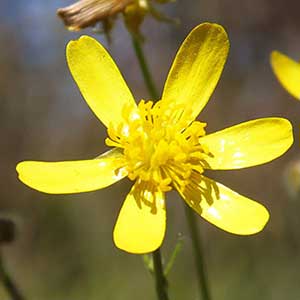Ranunculus sceleratus
Ranunculus austro-oreganus
blister buttercup, celery-leaf buttercup, celery-leaf crowfoot, cursed buttercup, cursed crowfoot, cursed crowsfoot, renoncule scélérate
southern Oregon buttercup
never tuberous.
erect, glabrous, rooting at base, only very rarely rooting at proximal nodes.
erect or ascending, never rooting nodally, crisped-pilose, base not bulbous.
basal and cauline, basal and proximal cauline leaf blades reniform to semicircular in outline, 3-lobed or -parted, 1-5 × 1.6-6.8 cm, base truncate to cordate, segments usually again lobed or parted, sometimes undivided, margins crenate or crenate-lobulate, apex rounded or occasionally obtuse.
broadly rhombic to semicircular in outline, 3-parted, 2.8-4.3 × 3-5.5 cm, segments 3-lobed, ultimate segments lanceolate, margins entire or toothed, apex narrowly acute or acuminate.
receptacle pubescent or glabrous;
sepals 3-5, reflexed from or near base, 2-5 × 1-3 mm, glabrous or sparsely hirsute;
petals 3-5, 2-5 × 1-3 mm;
nectary on petal surface, scale poorly developed and forming crescent-shaped or circular ridge surrounding but not covering nectary;
style absent.
receptacle glabrous;
sepals reflexed 1 mm above base, 4-6 × 1.5-3 mm, densely pilose;
petals 5, abaxially red, adaxially yellow, 10-12 × 4-6 mm.
ellipsoid or cylindric heads, 5-13 × 3-7 mm;
achenes 1-1.2 × 0.8-1 mm, glabrous;
beak deltate, usually straight, 0.1 mm.
hemispheric, 4-7 × 7-10 mm;
achenes 3.4-4.2 × 2.8-3.2 mm, sometimes basally pilose, margin forming narrow rib 0.1-0.2 mm wide;
beak persistent, lance-subulate, straight or somewhat curved distally, 1.6-2.6 mm.
Ranunculus sceleratus
Ranunculus austro-oreganus
Varieties 2 (2 in the flora).
Ranunculus sceleratus varieties were used by the Thompson Indians as a poison for their arrow points (D. E. Moerman 1986).
(Discussion copyrighted by Flora of North America; reprinted with permission.)
Of conservation concern.
Ranunculus austro-oreganus is doubtfully distinct from R. occidentalis var. howellii. L. D. Benson (1954) described the stem as bulbous-based and similar to that of R. bulbosus, but a differentiated base is not evident in material I have seen (some of which was cited by Benson).
(Discussion copyrighted by Flora of North America; reprinted with permission.)
1. Faces of achene with fine transverse wrinkles; leaf blades lobed or parted, segments undivided or lobed, margins crenate. | var. sceleratus |
1. Faces of achene smooth; leaf blades always parted (often deeply so), segments lobed or parted, margins deeply crenate or lobulate. | var. multifidus |
- Local floras:
BC,
CA,
OR,
WA
- Local Web sites:
CalFlora,
CalPhotos,
Flora NW,
Go Botany,
IL Wildflowers,
KS Wildflowers,
LA Plants,
MD Biodiversity,
MI Flora,
MN Wildflowers,
MO Plants,
PNW Herbaria,
Turner Photog.
WildflowerSearch
iNaturalist (observations)
USDA Plants Database
- LBJ Wildflower Center
- SEINet
- Plants of the World Online
- Encyclopedia of Life
- Wikipedia
- Google Image Search
- Local floras:
OR
- Local Web sites:
Flora NW,
PNW Herbaria
WildflowerSearch
iNaturalist (observations)
- LBJ Wildflower Center
- SEINet
- Plants of the World Online
- Encyclopedia of Life
- Wikipedia
- Google Image Search
